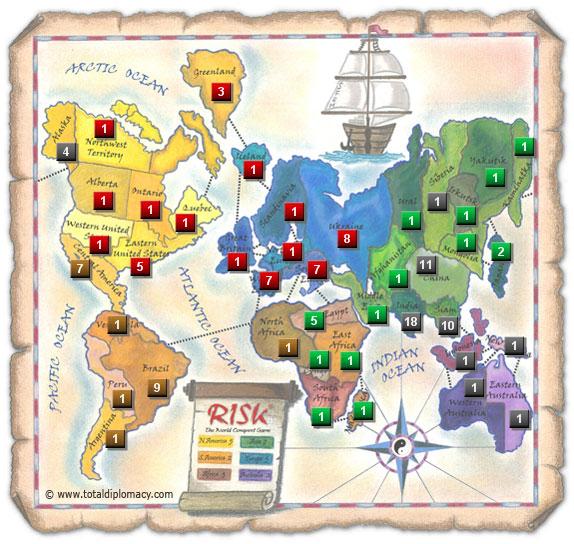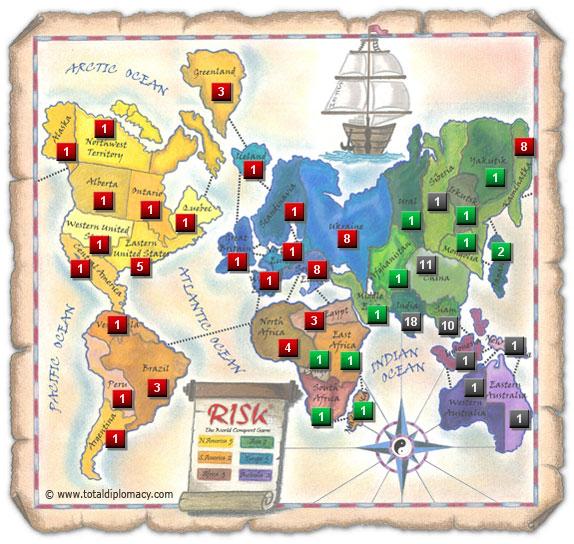You have battled your way through the game. It wasn’t easy and you are glad that you have survived. You really want to win. You have now come to a really decisive point. You have an advantage and you don’t want to blow it up.
End-games in Risk are quite tricky. There is only one winner and when you get to a certain stage, a single mistake or a missed opportunity means you will lose the game and leave the trophy for someone else.
Consider the dilemma you may face in the following game where you are playing as Red. You have eliminated a player who was dominant in North America and have cashed in his cards. You have a choice to place armies on the map and carry on with your march. But you want to pause and think for a second. What are your options? How can you make sure that you will win by choosing the best move possible? You don’t want to leave it to chance. You want that trophy really badly!

Risk Map: WhoToEliminate_1 --- Open Copy in Risk Map Editor
The game is played with escalating cards 4,6,8,10,… You have received 22 armies that you can place on the map.
Brown, Black and Green all have 4 cards and are likely to have a set. So if you don’t take Brown or Green out, they will come back to cause all sorts of trouble. You think this is a perfect opportunity. You can do a chain; eliminate one player, cash his cards, move on to the next player and so on.
So you decide to start with Brown. You invade South America, remove Brown and cash his cards as planned. Perfect! You think the plan is going really well. That gives you another 24 armies. So you distribute them on the map in strategic places preparing your empire for an attack on Green. You start attacking Africa. However, your luck runs out and you lose many armies in the process. In another front, you attack Alaska and that turns out just as bad. You cannot believe it! Suddenly you realise that this is not going as well as you hoped for and you stop before it’s too late. This is the how the map looks like now.

Risk Map: WhoToEliminate_2 --- Open Copy in Risk Map Editor
You realise that you can no longer take Green out. Bummer! He has 4 cards. This is a big problem. The game’s turn order is set to simultaneous. It means that after your turn, Green or Black can play whoever plays first. You simply don’t know who is going to do that. If Black is going to play first
and has a set of cards, then he will obviously go for Green to get his cards. Even though you have 5 cards now and will cash them in the next turn, you are not quite sure if you can manage to defend yourself. Of course if Green plays first
and if
he has cards to cash, he is most likely going to reinforce himself and even attack you. Both cases are bad news for you. Not only this will lengthen the game, but it will put you and Green in a potential conflict to the benefit of Black. You don’t want to believe that you lost because of bad luck. You want to know what you could have done so that, irrespective of luck, you would have ended up in a better position.
Should you have attacked Green instead of Brown? Should you have not attacked any of them and just reinforced? This would have meant that someone else could have cashed and eliminated a weaker player and effectively make a chain potentially attacking you in the process as well.
As it turned out, Black cashed in his cards, eliminated Green, got a lot more armies, invaded Red and eventually won the game.
You lost the game, but you feel you could have had it if it wasn’t because of bad luck. But since you don’t want to blame luck, you wonder what could you have done to end up as the winner or at least recover from bad luck. Of course, sometimes you are just not meant to win the game, but then again, why not?
What do you think? Is it possible to turn the it around, even if you had bad luck? Is dice that critical? Should Napoleon or Hitler blame the cold Russian winters for their failure, or was it that they didn’t account for it properly in their strategies?